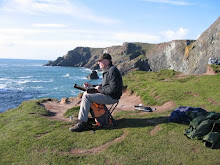
Lesson 2
Complimentary colours and keeping it simple with oil techniques.
Materials: Stiff hog hair brushes one large one small. Red, Blue, Yellow and white. Work at an angle if possible.
The complementary colour of a primary (red, blue, or yellow) is the colour you get by mixing the other two primary colors.
If we take red then the two primaries left are blue and yellow are and together they make green, so green is the complimentary of red.
If we take blue then the two primaries left are yellow and red and together they make orange, so the complimentary of blue is orange.
If we take yellow then the two primaries left are red and blue and together they make violet, so the complimentary of yellow is violet.
The complementary of a secondary color is the primary color that wasn't used to make it. So the complementary color of green is red, of orange is blue, and of purple is yellow.
Why are Complementary Colors Important in Color Theory?
When placed next to each other, complementary colors make each other appear brighter, more intense. The shadow of an object will also contain its complementary color, for example the shadow of a green apple will contain some red.
In the last lesson we moved colour into shadow by mixing in progressively darker tones of the same colour family. For example yellow could be darkened with yellow ochre, burnt sienna right through to burnt umber. Another way to darken a colour down is to add its complementary colour or its opposite on the colour wheel.
Keep it Simple
· Avoid over mixed palette colours. The less mixing you do the richer your paint quality will be, one way is to let your colour mix on the paper.
· Have ample amounts of paint, if you finish with a clean palette you either got lucky or skimped on the paints.
· Use as few brush strokes as it takes, don’t fiddle.
· Keep it simple and don’t try to overdo the detail.
Complimentary colours and keeping it simple with oil techniques.
Materials: Stiff hog hair brushes one large one small. Red, Blue, Yellow and white. Work at an angle if possible.
The complementary colour of a primary (red, blue, or yellow) is the colour you get by mixing the other two primary colors.
If we take red then the two primaries left are blue and yellow are and together they make green, so green is the complimentary of red.
If we take blue then the two primaries left are yellow and red and together they make orange, so the complimentary of blue is orange.
If we take yellow then the two primaries left are red and blue and together they make violet, so the complimentary of yellow is violet.
The complementary of a secondary color is the primary color that wasn't used to make it. So the complementary color of green is red, of orange is blue, and of purple is yellow.
Why are Complementary Colors Important in Color Theory?
When placed next to each other, complementary colors make each other appear brighter, more intense. The shadow of an object will also contain its complementary color, for example the shadow of a green apple will contain some red.
In the last lesson we moved colour into shadow by mixing in progressively darker tones of the same colour family. For example yellow could be darkened with yellow ochre, burnt sienna right through to burnt umber. Another way to darken a colour down is to add its complementary colour or its opposite on the colour wheel.
Keep it Simple
· Avoid over mixed palette colours. The less mixing you do the richer your paint quality will be, one way is to let your colour mix on the paper.
· Have ample amounts of paint, if you finish with a clean palette you either got lucky or skimped on the paints.
· Use as few brush strokes as it takes, don’t fiddle.
· Keep it simple and don’t try to overdo the detail.




















